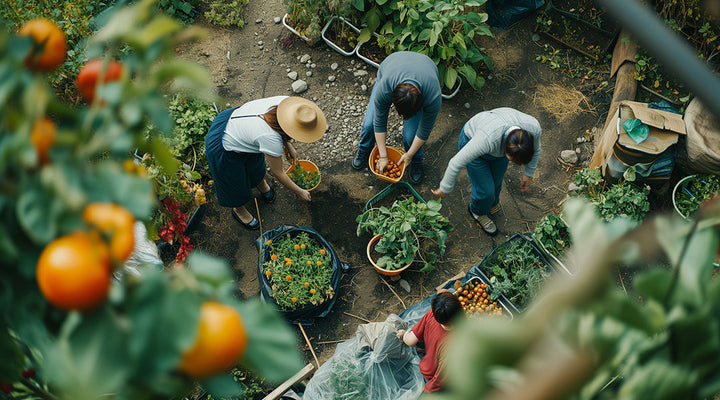
Problems And Solutions At The Intersection Of Environmental Health And Global Coffee Shortages
The biggest problem most of us face when it comes to coffee is having to impatiently wait a moment or two for that first cup to brew in the morning.
However, there could be bigger problems on the horizon!
And, we’re not talking about needing to run to the local grocery store for cream and/or sugar either.
Over the course of the last few years, there have been growing concerns surrounding our beloved morning (and all day) brew due to coffee shortages experienced across the globe.
And, while there are a number of things affecting coffee supply, one of the greatest concerns involves weather - temperature changes, variations in rainfall including drought, destruction due to weather, etc.
Like most plants, coffee shrubs are greatly affected by weather changes. Even the pests, pollinators, neighboring plants, and native wildlife - all of which are needed for healthy coffee production - are negatively affected by these factors, which means the growth of our favorite bean is hindered even further.
Here in the US we’re not in prime coffee growing territory, so we can often be oblivious to the issues facing those regions where coffee is commonly grown.
In fact, sometimes we don’t even realize there’s a problem until prices are affected by such shortages, or heaven forbid, we’re not able to sip our favorite brew due to these strains on the industry.
So then, what’s a coffee lover to do?
How serious is this problem?
And, how big of an impact does the environment truly have on coffee growth?
To fully understand this situation, let’s take some time to look at what’s causing this global shortage, how this might affect coffee drinkers, and then ultimately, let’s examine the importance of environmental health in growing coffee…because what good is detailing a problem without an honest focus on a viable solution?
Global Coffee Shortage Contributors

Before we can discuss solutions, let’s first define and detail the problem.
As we mentioned above, the problem coffee farmers, roasters, companies, and consumers are facing is one pertaining to supply.
And, when it comes to coffee, the supply chain can be broken down into four stages: sourcing, processing, distribution, and sales.
Concerning sourcing, this involves how the coffee is grown and harvested.
Processing then involves how the coffee cherries are cleaned or washed, dried, and prepared for export.
Distribution, of course, deals with how the coffee makes its way to either distributors or to you, the consumer.
And lastly, sales involve both the total demand for a product as well as the type of demand (do consumers want more organic coffees, specialty coffees, conventional, etc.).
But, getting deeper into the supply problem facing the coffee industry, this issue is actually multifaceted…
First, the supply of coffee around the globe is wildly insufficient right now.
The reason? Simply stated, more and more folks are drinking coffee today.
For instance, one country, in particular, that has made headlines regarding an increase in coffee consumption is China.
Typically, this region is known for their love of tea, but in recent years, China has noticed a shift, with folks now being more inclined to drink coffee.
And, Chinese consumers aren’t just satisfied with any old brew.
No, like many others around the globe, they too see the benefit of drinking clean, healthy coffee, which has led to an increase in demand for specialty and single origin beans.
Of course, this example only shows a small sector of the industry where demand is rising.
Overall, in the last decade the popularity of coffee has soared.
In fact, during this time the demand for coffee has risen by nearly 40%, a twenty-year high!
Then, there’s the weather battle.
Coffee plants are very sensitive to changes in weather patterns. And, as we all know, the weather has been changing a lot lately.
Most coffee is grown in temperate or tropical climates.
This is because the plants need consistently warm temperatures, protection from frost, a decent amount of rainfall, high humidity, and a mixture of shade and sunlight for optimal growth.
The Coffee Belt, or the regions closest to the equator, typically meets these needed climate specifications, but in recent years these conditions have been threatened.
Brazil is the world’s largest producer of Arabica coffee, for instance, and recently the coffee growing regions within the country have suffered severe drought combined with brutally harsh frosts very late in the season.
Both events have caused damage to coffee shrubs as well as a seriously diminished crop yield.
Farmers have detailed that they’ve gone through much of their bumper crops but demand far exceeds what they’ll be able to provide due to these losses.

Then, Vietnam is the second largest producer of coffee in the world, and this country has also experienced harsh weather conditions.
Here, heavy rains in 2023 completely ruined many coffee harvests, negatively affecting the global coffee supply even more.
And, aside from temperature anomalies, drought, and heavy rainfall, some regions in Central America have suffered much devastation, here due to hurricanes in recent years.
All of these things combine to essentially signify a serious supply problem, one consumer have noticed over the last few years as availability has decreased and prices have increased.
Of course, as far as the market is concerned, this simply boils down to supply and demand.
Low demand plus high supply equals a surplus, and this drive prices down.
High demand plus low supply equals a shortage, and this drive prices up.
Unfortunately for coffee lovers, the latter is what we’re experiencing.
But, price isn’t even the greatest concern the coffee industry is facing.
The greater crisis we’re facing concerns the environment.
A healthy environment means everything when it comes to weather conditions, temperatures, soil, biodiversity, and ultimately coffee production.
When the health of our planet suffers, coffee supply suffers, and this is the problem we’re living out right now.
Environmental Health And Growing Coffee

Clearly, environmental changes, such as climate change, present a very real problem regarding coffee production.
And, whenever you have a problem, seeking a solution is paramount.
Some studies have suggested the coffee shortage problem may be solved, in part, by expanding growing regions to include parts of Argentina, Chile, northern Spain, and even the southernmost portions of the United States.
However, most experts find this solution to be unrealistic.
One solution scientists and many others in this industry do know to be effective, however, involves how coffee is grown and processed.
Essentially, as we looked at the four stages of the supply chain in the section above, this can be used as a guideline.
If we view each area through the lens of improving and preserving environmental health, we’ll truly be on our way to mitigating climate change and prioritizing the health of our planet, all while growing clean, healthy coffee.
So, let’s use those stages as a guide, first looking at sourcing.
As we mentioned above, sourcing involves production, and when it comes to coffee production, in some ways I guess you can look at coffee growth and the environment as a symbiotic relationship.
When grown naturally, working with the environment, coffee plants are nourished by a healthy environment. The plants receive adequate sunshine, rich nourishment from the soil, health and life from falling rain, and even protection from other plants, insects, and wildlife living within the same region.
On the flip side of this, the environment thrives, in part, due to the presence of the coffee plants.
As the plants grow, the air quality improves, the soil is enriched, water quality is enhanced, and climate change is mitigated.
But, when either of these are disturbed or altered, one or both suffer.
Take conventional or mass marketed coffee production, for instance - these growing methods have made a drastic impact on the environment, and not in a good way.
To keep up with increasing demands, conventional coffee growers acquire large portions of land within the coffee belt. Since they need to produce as much coffee as possible, as fast as possible, they commonly strip large areas of land, removing all trees and other plant life to make room for rows and rows of coffee shrubs.
This massively disrupts the existing ecosystem, forcing wildlife to relocate. And, it greatly degrades the quality of the land in the long run.

Then, to accelerate growth and accommodate for less than ideal (full sun) conditions for coffee plants to thrive, these plantations are often heavily sprayed with fertilizers, pesticides, herbicides, fungicides, etc.
This practice further damages the soil, depleting nutrients for years to come, but it also harms wildlife and neighboring plant life, contaminates nearby waterways, and more.
In most cases, even coffee plant growth dwindles after a few years in these conditions as the soil becomes too acidic for plants to thrive.
So, these types of growers then simply pick up, move to another region, and the process begins all over again.
Thankfully, consumers are becoming more and more aware of these environmentally detrimental practices, therefore many are demanding sustainability.
What is sustainability, exactly?
Well, in short, sustainability is one of the best ways to ensure environmental health, especially when it comes to growing coffee.
As coffee is one of the most popular beverages in the world, sustainable farming practices are an absolute necessity if we’re going to reduce the environmental impact its growth has.
So then, what does a healthy relationship between coffee production and the environment look like?
For starters, growing coffee sustainably means absolutely no deforestation!
Coffee thrives best when it’s growing amongst other plant life.
In fact, many conventional coffee plantations actually have to use hybrid plants to accommodate being commonly grown in full sun.
But, when coffee farmers, instead, plant rows of coffee shrubs amidst native flora, this not only benefits the coffee plants, providing them with shade, shelter, and enriched soil due to composting leaves and other plant matter, it also enriches native plants in similar ways.
Planting coffee shrubs in this manner also brings in new pollinators, insects, small rodents, and other wildlife into the area.

Can you see the sustainability of this model already?
We’ve not even gotten into the heart of sustainable growing practices, and already the biodiversity of the area has increased, benefiting all plant and animal life in the region while also enriching the soil.
Protecting ecosystems in this way, even enhancing these areas, keeps our planet healthy.
Then, sustainable farming methods are also characterized by a commitment to keep all chemicals out of the growing process.
This protects soil health, plant life, wildlife, air, and water quality. But, it also preserves and protects the fragile ecosystems in the region.
It even combats climate change, as conventional growing methods (including the use of harsh chemicals in these processes) commonly cause a greater release of greenhouse gases.
The goal of sustainably grown coffee is one shared by many, and its overall aim is to reduce the negative impact the production of goods can have on the environment.
And, when these measures are taken during the coffee growing process, everybody wins!
But, is this enough?
Sustainable farming methods indeed seek to reduce the environmental impact of coffee production, but with the demand for even specialty, sustainably grown, coffee on the rise, and considering the negative impact conventionally grown coffee has on the planet, there’s a greater need for greater solutions.
One solution that has a lot in common with sustainable farming is regenerative agriculture.
Sustainable growing practices center around a focus on preserving agroecosystems for the future and for overall environmental health.
But, regenerative agriculture seeks to restore and rebuild those natural processes that have diminished over time.
Regenerative agriculture also mirrors sustainable farming in many ways as it aims to teach farmers about ‘best production practices,’ seeks to improve soil health, protect ecosystems, and even increase biodiversity in coffee growing regions.
“Regenerative agriculture focuses on creating harmony between the three pillars of sustainability: economic, environmental, and social…ultimately this means both coffee quality and yields can improve, while carbon footprint falls and land use efficiency rises.”
And frankly, isn’t that exactly what we need when it comes to coffee production?
Unfortunately, even if we completely clean up coffee growing practices all around the world, there’s still work to be done…
Enter the next step in the coffee supply chain - processing.

This step, depending on the method used, can involve a lot of water. And, again depending on methods, this step can also lead to pollution with improper waste management.
Thankfully, the solution of sustainable practices brings another win!
When companies (such as Lifeboost) focus on sustainability, even while processing freshly harvested coffee, the health of the environment is prioritized.
Here, “sustainable processing practices focus on reducing [both] water usage and waste production.”
As you have likely guessed, washing methods for conventionally grown coffee pose a double threat to the planet, as the initial use of harsh chemicals in the growing process negatively affects the health of the region, but then as the coffee cherries are washed and processed, these chemicals can once again be released into the environment, especially when wastewater isn’t managed properly.
With sustainable processing methods, since such chemicals are not used, you don’t have to worry about contamination in the first place. But, the added bonus here is that sustainability practices also cut down on the amount of waste and water as a whole.
Now for distribution.
This can be a big one when it comes to environmental health, and that’s why companies vary in their efforts to mitigate environmental damage due to transport and distribution.
While we can’t speak for other companies, here at Lifeboost we tackle this problem with an environmental health focus concerning our packaging and shipping.
Then, realizing the magnitude of the impact here, we also seek to offset our carbon footprint in a few other ways.
First, we use EcoCart. By using this service, we’ve been able to offset the impact of shipping in a powerful way.
But, we also contribute here by financially supporting organizations and efforts which protect and preserve some of the most vulnerable regions of our planet.
Finally, that last step, sales, this is where you come in!

As consumers, we can all make a difference when we demand better.
Every time you choose sustainably grown coffee, you’re choosing to prioritize environmental health as well.
By choosing ethical and sustainably grown coffee, you are in fact prioritizing “environmental protection, fair trade, and social responsibility throughout the supply chain.”
As a consumer, when you choose sustainably grown coffee, you are also choosing transparency and responsibility.
And, when you choose sustainability, you are prioritizing people and the planet!
The bottom line…
The goal of producing clean, healthy coffee can and should effortlessly mirror goals regarding the health of our planet.
When healthy coffee, healthy people, and a healthy planet are all at the heart of production, processing, and distribution, and when consumers demand sustainability, climate change can be effectively mitigated, coffee supply chains can thrive, and the health of consumers has the potential to thrive too, as we enjoy nutrient-rich, organic, sustainably grown, healthy coffee!
Check out Lifeboost Coffee Grata Medium Roast.

Becky is a mother, educator, and content writer for Lifeboost Coffee. She has had three years’ experience as a writer, and in that time she has enjoyed creatively composing articles and ebooks covering the topics of coffee, health and fitness, education, recipes, and relationships.
- https://www.ecotactbags.com/blog/exploring-the-global-coffee-shortage-and-the-rising-demand-from-china#
- https://www.ncausa.org/Newsroom/Daily-coffee-consumption-at-20-year-high-up-nearly-40#
- https://coffeegeek.com/blog/farming/coffee-in-crisis-climate-changes-impact/
- https://www.hhc.earth/knowledge-base/articles/why-the-climate-crisis-affects-the-price-of-your-cup-of-coffee
- https://digitalweekday.com/2024/09/27/global-coffee-shortage-how-brazils-drought-is-impacting-your-morning-brew/
- https://www.newson6.com/story/67c046178335b559a5ee6bed/coffee-prices-increasing-poor-harvest-global-shortage#
- https://lincolnandyork.com/learning-hub/blog/are-we-facing-a-global-coffee-shortage/
- https://www.carbonclick.com/news-views/the-environmental-impact-of-coffee-growing-and-transportation
- https://ohiostate.pressbooks.pub/sciencebites/chapter/a-bitter-brew-coffee-production-deforestation-soil-erosion-and-water-contamination/#
- https://perfectdailygrind.com/2023/08/soil-health-regenerative-agriculture-coffee/#
- https://perfectdailygrind.com/2022/08/exploring-regenerative-agriculture-in-coffee-production/
- https://www.suterra.com/blog/regenerative-vs.-sustainable-agriculture#
- https://tracextech.com/sustainable-coffee-supply-chain/#
- https://tapestrycoffeemn.com/blogs/news/what-does-sustainability-mean-in-coffee#
- https://link.springer.com/article/10.1007/s13201-019-1091-9
- References for the article to confirm data and information.










